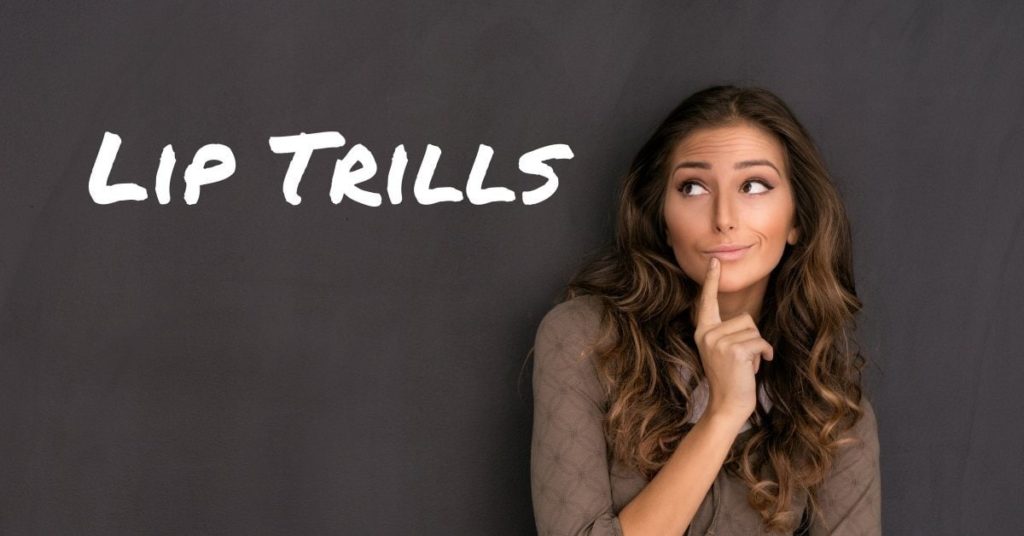
A very popular warm-up exercise is the "lip trill" or the "lip bubble." This is an excellent vocal exercise for all levels of singers to gently warm up the voice (vocal cords), lips, and facial muscles. It also helps with practicing breath management as you need a steady flow of air to do this exercise.
Lip Trills Explained
This lip roll (bubble or trill) vocal exercise is classified as a "Semi-Occluded Vocal Tract" exercise. This term means that the mouth is partially closed to create negative air pressure or "back pressure" to the vocal folds.
You will often see singers warming up with this "SOVT" exercise before performances or auditions, and perhaps you have even had a voice teacher ask you to do this exercise in a voice lesson.
But why should you do these lip trill exercises, and why is it a good warm-up?
Well, the magic of lip trills is that we are creating some secondary resistance. Resistance is key in singing because when we resist the flow of air, we start pressing the air molecules together, building energy so that when they are released, we get a sound wave. This "excited" moving air helps the vocal cords do their job more easily.
The lips also create a little more resistance of airflow and so it kind of slows the flow of air down and helps press back some of that energy towards the vocal cords, which helps the vocal cords hold back and compress the air. So essentially, the lips are like assistance.
Practicing a sustained continuous trill on a long slide can also increase the sensation of the vocal transitions and where the resonances go, which is important for learning to sing higher. So one of my favorite warm-ups is lip trill exercises or lip bubbles.
Warming Up the Facial Muscles
Another objective of lip trills is to create relaxation in the facial muscles. If you have facial muscular tension, you will not be able to do a consistent lip trill, and if you're engaging in excess muscle as you go higher, the lip bubble will warn you by ceasing to work. So lip trills are a great way to help relax your face muscles and help to remove tension.
You will also notice there has to be a certain amount of relaxation in the jaw to be able to put the lips in an optimal place for steady lip bubbles, so if you are clenching the jaw muscles, it will be hard to trill those lips.
Breath Control
When we practice a correct lip trill, it also requires us to be able to provide a steady flow of air and maintain this airflow through the exercise. This is especially true when practicing a sustained, ongoing lip trill.
The coordination between breath support, relaxation, and placement that you need for trills will also increase your general awareness of your voice. This awareness can help with other singing techniques, range extension, and muscle coordination.
So while practicing a proper lip trill, you are also practicing breath management skills and overall vocal balance.
How to Practice Lip Trills

So how do you practice lip bubble exercises? First, you want to find a relaxed position where you can comfortably breathe, and you don't want to feel tension or strain in your neck or shoulders. It is best to stand or sit upright with a good singing posture.
You then want to take a deep breath in, expanding the ribs and belly, and exhale slowly while keeping your lips pursed. The trick here is to keep your lips pursed but not tight enough that they pinch off the air supply. Instead, your lips should remain slightly open to allow the air to pass through them.
Keep the jaw loose and slightly dropped and slightly forward, as this helps to align the lips and keep them relaxed. It is a bit of a balancing act of coordinating the relaxation and steady breath pressure through this position.
If you have trouble getting the lip trilling going, place your index fingers at the sides of the mouth by the cheeks and gently press forward to help the lips get into the correct position. Try different placements of jaw and lips until you start to get some bubbles.
Another thing you can try to get that "bubbling" feeling is to try tongue trills. This is a similar exercise, but the breath pressure's rolling feel is bubbling through the end of the tongue lightly pressed against the roof of the mouth. Tongue trills also take coordination of a relaxed yet controlled tongue, relaxed facial muscles, and consistent breath flow. If this is easier, start with this exercise to get the feel of steady breath flow through the tongue trill, and then you can move to a lip trill pattern.
If you find it hard to get the trill sound production going, just keep at it as it can be like riding a bike; once you get the feeling, it tends to just click. So remember, practice makes perfect!
If you would like to learn more about my books, courses, and John's Singing School, please visit johnhenny.com. And if you are interested in online vocal lessons, you can reach out to our front desk at [email protected], and we would be happy to answer your questions.